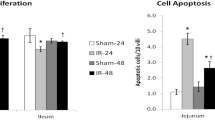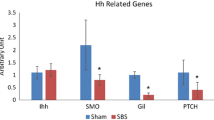Abstract
Background
Notch signaling is required for the maintenance of intestinal epithelial proliferation. Dysfunction of this signaling pathway is associated with the loss of proliferated crypt epithelial cells.
Aim
The aim of this study was to investigate the role of Notch signaling in small bowel resection (SBR)-associated crypt epithelial cell proliferation.
Methods
Male Sprague–Dawley rats were subjected to sham operation (bowel transection and reanastomosis) or 70 % mid-SBR. Intestinal tissue samples were collected at 0.5, 1, 6, 12, 24, 72, and 168 h after operation. The expression of Notch pathway mRNAs and proteins was analyzed using RT-PCR and Western blot. The expression of the Notch pathway proteins Jagged-1, NICD and Hes-1 was also determined through immunohistochemical staining using day 3 postoperative intestinal tissues. The degree of crypt epithelial cell proliferation was evaluated using the immunohistochemical staining of proliferating cell nuclear antigen (PCNA). Furthermore, IEC-6 cells were used to examine the function of the Jagged-1 signaling system.
Results
SBR led to increased crypt epithelial cell proliferation and increased expression of Jagged-1 and Hes-1 mRNA and protein along with cleaved Notch-1. Immunohistochemical staining showed that Jagged-1, cleaved Notch-1 and Hes-1 colocalized in the same proliferated crypt epithelial cell population. Recombinant Jagged-1 significantly stimulated the proliferation of IEC-6 cells. Transient upregulation of Jagged-2 expression was found 1 h after SBR, and it was accompanied by cleaved Notch-1 and Hes-1 upregulation.
Conclusion
The Jagged-1/Notch-1/Hes-1 signaling pathway is involved in intestinal adaptation through increasing crypt epithelial cell proliferation.






Similar content being viewed by others
References
Potten CS, Wilson JW, Booth C. Regulation and significance of apoptosis in the stem cells of the gastrointestinal epithelium. Stem Cells. 1997;15:82.
Williamson RC. Intestinal adaptation (second of two parts). Mechanisms of control. N Engl J Med. 1978;298:1444–1450.
Williamson RC. Intestinal adaptation (first of two parts). Structural, functional and cytokinetic changes. N Engl J Med. 1978;298:1393–1402.
Botsios DS, Vasiliadis KD. Factors enhancing intestinal adaptation after bowel compensation. Dig Dis Sci. 2003;21:228–236.
Baron M. An overview of the Notch signalling pathway. Semin Cell Dev Biol. 2003;14:113–119.
Artavanis-Tsakonas S, Rand MD, Lake RJ. Notch signaling: cell fate control and signal integration in development. Science. 1999;284:770–776.
Riccio O, van Gijn ME, Bezdek AC, et al. Loss of intestinal crypt progenitor cells owing to inactivation of both Notch1 and Notch2 is accompanied by derepression of CDK inhibitors p27Kip1 and p57Kip2. EMBO Rep. 2008;9:377–383.
Murata K, Hattori M, Hirai N, et al. Hes1 directly controls cell proliferation through the transcriptional repression of p27Kip1. Mol Cell Biol. 2005;25:4262–4271.
Bernal NP, Stehr W, Zhang Y, Profitt S, Erwin CR, Warner BW. Evidence for active Wnt signaling during postresection intestinal adaptation. J Pediatr Surg. 2005;40:1025–1029.
Tang Y, Swietlicki EA, Jiang S, et al. Increased apoptosis and accelerated epithelial migration following inhibition of hedgehog signaling in adaptive small bowel postresection. Am J Physiol Gastrointest Liver Physiol. 2006;290:G1280–G1288.
Schröder N, Gossler A. Expression of Notch pathway components in fetal and adult mouse small intestine. Gene Expr Patterns. 2002;2:247–250.
Sander GR, Powell BC. Expression of notch receptors and ligands in the adult gut. J Histochem Cytochem. 2004;52:509–516.
Struhl G, Greenwald I. Presenilin is required for activity and nuclear access of Notch in Drosophila. Nature. 1999;398:522–525.
Bailey AM, Posakony JW. Suppressor of hairless directly activates transcription of enhancer of split complex genes in response to Notch receptor activity. Genes Dev. 1995;9:2609–2622.
Fre S, Huyghe M, Mourikis P, Robine S, Louvard D, Artavanis-Tsakonas S. Notch signals control the fate of immature progenitor cells in the intestine. Nature. 2005;435:964–968.
Stanger BZ, Datar R, Murtaugh LC, Melton DA. Direct regulation of intestinal fate by Notch. Proc Natl Acad Sci USA. 2005;102:12443–12448.
Ueo T, Imayoshi I, Kobayashi T, et al. The role of Hes genes in intestinal development, homeostasis and tumor formation. Development. 2012;139:1071–1082.
Bar Y, Russ HA, Knoller S, Ouziel-Yahalom L, Efrat S. HES-1 is involved in adaptation of adult human beta-cells to proliferation in vitro. Diabetes. 2008;57:2413–2420.
Köhler C, Bell AW, Bowen WC, Monga SP, Fleig W, Michalopoulos GK. Expression of notch-1 and its ligand jagged-1 in rat liver during liver regeneration. Hepatology. 2004;39:1056–1065.
Adolphe C, Wainwright B. Pathways to improving skin regeneration. Expert Rev Mol Med. 2005;7:1–14.
Kobayashi T, Terada Y, Kuwana H, et al. Expression and function of the Delta-1/Notch-2/Hes-1 pathway during experimental acute kidney injury. Kidney Int. 2008;73:1240–1250.
Croquelois A, Domenighetti AA, Nemir M, et al. Control of the adaptive response of the heart to stress via the Notch1 receptor pathway. J Exp Med. 2008;5:3173–3185.
Siveke JT, Lubeseder-Martellato C, Lee M, et al. Notch signaling is required for exocrine regeneration after acute pancreatitis. Gastroenterology. 2008;134:544–555.
Ma XB, Jia XS, Liu YL, et al. Expression and role of Notch signalling in the regeneration of rat tracheal epithelium. Cell Prolif. 2009;42:15–28.
Okamoto R, Tsuchiya K, Nemoto Y, et al. Requirement of Notch activation during regeneration of the intestinal epithelia. Am J Physiol Gastrointest Liver Physiol. 2009;296:G23–G35.
Wang W, Xiao W, Sun L, Zhang C, Chen G, Yang H. Inhibition of ACE activity contributes to the intestinal structural compensation in a massive intestinal resection rat model. Pediatr Surg Int. 2012;28:533–541.
van Es JH, van Gijn ME, Riccio O, et al. Notch/gamma-secretase inhibition turns proliferative cells in intestinal crypts and adenomas into goblet cells. Nature. 2005;435:959–963.
Wong GT, Manfra D, Poulet FM, et al. Chronic treatment with the gamma-secretase inhibitor LY-411,575 inhibits beta-amyloid peptide production and alters lymphopoiesis and intestinal cell differentiation. J Biol Chem. 2004;279:12876–12882.
Milano J, McKay J, Dagenais C, et al. Modulation of notch processing by gamma-secretase inhibitors causes intestinal goblet cell metaplasia and induction of genes known to specify gut secretory lineage differentiation. Toxicol Sci. 2004;82:341–358.
Kwon SM, Eguchi M, Wada M, et al. Specific Jagged-1 signal from bone marrow microenvironment is required for endothelial progenitor cell development for neovascularization. Circulation. 2008;118:157–165.
Jundt F, Pröbsting KS, Anagnostopoulos I, et al. Jagged1-induced Notch signaling drives proliferation of multiple myeloma cells. Blood. 2004;103:3511–3515.
Reedijk M, Odorcic S, Zhang H, et al. Activation of Notch signaling in human colon adenocarcinoma. Int J Oncol. 2008;33:1223–1229.
Skipper M, Lewis J. Getting to the guts of enteroendocrine differentiation. Nat Genet. 2000;24:3–4.
van Den Brink GR, de Santa Barbara P, Roberts DJ. Development. Epithelial cell differentiation—a Mather of choice. Science. 2001;294:2115–2116.
Warner BW, Vander Kolk WE, Can G, Helmrath MA, Shin CE, Erwin CR. Epidermal growth factor receptor expression following small bowel resection. J Surg Res. 1997;70:171–177.
Aguirre A, Rubio ME, Gallo V. Notch and EGFR pathway interaction regulates neural stem cell number and self-renewal. Nature. 2010;467:323–327.
Purow BW, Sundaresan TK, Burdick MJ, et al. Notch-1 regulates transcription of the epidermal growth factor receptor through p53. Carcinogenesis. 2008;29:918–925.
McMellen ME, Wakeman D, Erwin CR, Guo J, Warner BW. Epidermal growth factor receptor signaling modulates chemokine (CXC) ligand 5 expression and is associated with villus angiogenesis after small bowel resection. Surgery. 2010;148:364–370.
Kayahara T, Sawada M, Takaishi S, et al. Candidate markers for stem and early progenitor cells, Musashi-1 and Hes1, are expressed in crypt base columnar cells of mouse small intestine. FEBS Lett. 2003;535:131–135.
Tang Y, Swietlicki EA, Jiang S, et al. Increased apoptosis and accelerated epithelial migration following inhibition of hedgehog signaling in adaptive small bowel postresection. Am J Physiol Gastrointest Liver Physiol. 2006;290:1280–1288.
Acknowledgments
This research was supported by grants from the National Natural Science Foundation of China (Nos. 81020108023, 81272078,81200288) and the Chongqing Science and Technology Commission International Key Collaboration Project (CSTC 201110008).
Conflict of interest
None.
Author information
Authors and Affiliations
Corresponding author
Rights and permissions
About this article
Cite this article
Chen, G., Sun, L., Yu, M. et al. The Jagged-1/Notch-1/Hes-1 Pathway Is Involved in Intestinal Adaptation in a Massive Small Bowel Resection Rat Model. Dig Dis Sci 58, 2478–2486 (2013). https://doi.org/10.1007/s10620-013-2680-3
Received:
Accepted:
Published:
Issue Date:
DOI: https://doi.org/10.1007/s10620-013-2680-3




